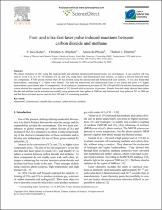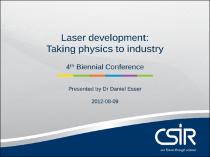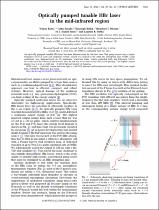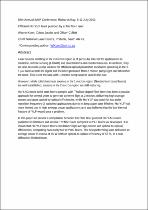 ResearchSpace
ResearchSpace
Fast- and ultra-fast laser pulse induced reactions between carbon dioxide and methane
JavaScript is disabled for your browser. Some features of this site may not work without it.
- ResearchSpace
- →
- Research Publications/Outputs
- →
- Journal Articles
- →
- View Item
| dc.contributor.author |
Kotze, FJ

|
|
| dc.contributor.author |
Strydom, CA

|
|
| dc.contributor.author |
Du Plessis, A

|
|
| dc.contributor.author |
Dlamini, TL

|
|
| dc.date.accessioned | 2011-02-23T15:12:25Z | |
| dc.date.available | 2011-02-23T15:12:25Z | |
| dc.date.issued | 2010-03 | |
| dc.identifier.citation | Kotze, F,J, Strydom, C,A, Du Plessis, A, et al. 2010. Fast- and ultra-fast laser pulse induced reactions between carbon dioxide and methane. Journal of natural gas chemistry, Vol. 19(2), pp 198-202. | en_US |
| dc.identifier.issn | 1003-9953 | |
| dc.identifier.uri | http://www.sciencedirect.com/science?_ob=MImg&_imagekey=B7W6T-5004N3S-M-1&_cdi=28559&_user=958262&_pii=S1003995309600578&_origin=search&_coverDate=03%2F31%2F2010&_sk=999809997&view=c&wchp=dGLzVzb-zSkzS&md5=724b742d47d10e25364522eb6a53efda&ie=/sdarticle.pdf | |
| dc.identifier.uri | http://hdl.handle.net/10204/4889 | |
| dc.description | Copyright:2010 Chengdu Institute of Organic Chemistry. Permission to self archive this work was granted by the Editorial Office of the Journal of Natural Gas Chemistry | en_US |
| dc.description.abstract | The direct excitation of CO2 using fast (nanosecond) and ultrafast (femtosecond) pulsed lasers was investigated. A gas reaction cell was used to excite CO2 in a 50 : 50 mixture of CO2 and CH4 using nano- and femtosecond laser systems, to induce a reaction between these two compounds. FT-IR spectra showed that CO was formed using the nanosecond and femtosecond laser systems. It was also found that hydrocarbons, containing C–C bonds were formed. For both the nanosecond and femtosecond laser, it was found that more C-C higher hydrocarbons were formed after 5 h compared to 3 h of irradiation. Irradiation at pressures of 250, 350 and 500 kPa with the femtosecond laser system showed the expected increase in the amount of CO formed with an increase in pressure. Results from this study showed that carbon dioxide and methane can be activated successfully using nanosecond laser pulses at 2000 nm and femtosecond laser pulses at 795 or 2000 nm and that these activated species react to form CO and C-C containing products. | en_US |
| dc.language.iso | en | en_US |
| dc.publisher | Chengdu Institute of Organic Chemistry | en_US |
| dc.relation.ispartofseries | Workflow request;4268 | |
| dc.subject | Laser pulse | en_US |
| dc.subject | Carbon dioxide | en_US |
| dc.subject | Methane | en_US |
| dc.subject | Ultrafast laser pulses | en_US |
| dc.subject | Tuneable laser systems | en_US |
| dc.subject | Fast laser pulses | en_US |
| dc.subject | Organic chemistry | en_US |
| dc.subject | Natural gas chemistry | en_US |
| dc.subject | Lasers | en_US |
| dc.title | Fast- and ultra-fast laser pulse induced reactions between carbon dioxide and methane | en_US |
| dc.type | Article | en_US |
| dc.identifier.apacitation | Kotze, F., Strydom, C., Du Plessis, A., & Dlamini, T. (2010). Fast- and ultra-fast laser pulse induced reactions between carbon dioxide and methane. http://hdl.handle.net/10204/4889 | en_ZA |
| dc.identifier.chicagocitation | Kotze, FJ, CA Strydom, A Du Plessis, and TL Dlamini "Fast- and ultra-fast laser pulse induced reactions between carbon dioxide and methane." (2010) http://hdl.handle.net/10204/4889 | en_ZA |
| dc.identifier.vancouvercitation | Kotze F, Strydom C, Du Plessis A, Dlamini T. Fast- and ultra-fast laser pulse induced reactions between carbon dioxide and methane. 2010; http://hdl.handle.net/10204/4889. | en_ZA |
| dc.identifier.ris | TY - Article AU - Kotze, FJ AU - Strydom, CA AU - Du Plessis, A AU - Dlamini, TL AB - The direct excitation of CO2 using fast (nanosecond) and ultrafast (femtosecond) pulsed lasers was investigated. A gas reaction cell was used to excite CO2 in a 50 : 50 mixture of CO2 and CH4 using nano- and femtosecond laser systems, to induce a reaction between these two compounds. FT-IR spectra showed that CO was formed using the nanosecond and femtosecond laser systems. It was also found that hydrocarbons, containing C–C bonds were formed. For both the nanosecond and femtosecond laser, it was found that more C-C higher hydrocarbons were formed after 5 h compared to 3 h of irradiation. Irradiation at pressures of 250, 350 and 500 kPa with the femtosecond laser system showed the expected increase in the amount of CO formed with an increase in pressure. Results from this study showed that carbon dioxide and methane can be activated successfully using nanosecond laser pulses at 2000 nm and femtosecond laser pulses at 795 or 2000 nm and that these activated species react to form CO and C-C containing products. DA - 2010-03 DB - ResearchSpace DP - CSIR KW - Laser pulse KW - Carbon dioxide KW - Methane KW - Ultrafast laser pulses KW - Tuneable laser systems KW - Fast laser pulses KW - Organic chemistry KW - Natural gas chemistry KW - Lasers LK - https://researchspace.csir.co.za PY - 2010 SM - 1003-9953 T1 - Fast- and ultra-fast laser pulse induced reactions between carbon dioxide and methane TI - Fast- and ultra-fast laser pulse induced reactions between carbon dioxide and methane UR - http://hdl.handle.net/10204/4889 ER - | en_ZA |








